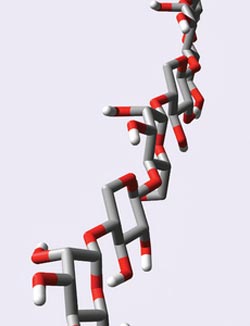Building a beetle antifreeze

A computer-generated image of the beetle antifreeze xylomannan reveals that one face bristles with oxygen atoms (red), forming a polar surface that helps it to cling to ice crystals. Copyright : 2012 Yukishige Ito<br>
Animals and plants have evolved all sorts of chemical tricks that allow them to colonize extreme environments. For species that call Antarctica or the Arctic home, surviving sub-zero temperatures is an essential ability, and chemists have isolated many natural antifreeze compounds from these organisms.
The antifreeze called xylomannan, which is produced by the freeze-tolerant Alaskan beetle Upis ceramboides, is being studied by Akihiro Ishiwata and Yukishige Ito at the RIKEN Advanced Science Institute at Wako and their colleagues. Their findings to date show that xylomannan is a particularly unusual antifreeze.
Xylomannan was first reported in 2009, and has been shown to be amongst the most active insect antifreezes found to date. Antifreeze compounds, which are also known as thermal hysteresis factors (THFs), protect the insects’ cells from damage as temperatures fall and ice crystals begin to form. THFs seem to work by sticking to the surface of nascent ice crystals and somehow stopping them from growing, protecting nearby cell membranes from being punctured by needles of ice.
The unusual thing about xylomannan is its constituents. Every natural THF isolated to date is protein based, but xylomannan is a glycan, a long-chain sugar-based compound. “Xylomannan is the first example of a THF biomolecule with little or no protein component,” says Ishiwata. “Its mode of action is not entirely clear, but it should be different to those of common THFs such as antifreeze proteins and glycoproteins.”
To confirm the proposed structure of xylomannan, so that they can begin to study how it interacts with ice crystals, Ishiwata, Ito and their colleagues synthesized what they thought to be a key component of the compound’s sugar-based backbone. Their structural analysis, using nuclear magnetic resonance techniques and molecular modeling, confirmed that the structure matches that of the natural compound. It also hints at the way that xylomannan might stick to ice crystals: one face of xylomannan is much more polar than the other face, making one face hydrophilic and the other hydrophobic..
“We propose that the hydrophilic phase of xylomannan might bind to the ice crystal, exposing the hydrophobic phase on the ice crystal’s surface,” says Ishiwata. This hydrophobic surface should repel water molecules away from the ice crystal, stopping it from growing any further. “However, the binding mode is still not clear from our structural analysis,” he adds. To test the theory further, the team now plans to synthesize longer fragments of xylomannan to examine their ice-binding ability.
The corresponding author for this highlight is based at the Synthetic Cellular Chemistry Laboratory, RIKEN Advanced Science Institute
Media Contact
All latest news from the category: Life Sciences and Chemistry
Articles and reports from the Life Sciences and chemistry area deal with applied and basic research into modern biology, chemistry and human medicine.
Valuable information can be found on a range of life sciences fields including bacteriology, biochemistry, bionics, bioinformatics, biophysics, biotechnology, genetics, geobotany, human biology, marine biology, microbiology, molecular biology, cellular biology, zoology, bioinorganic chemistry, microchemistry and environmental chemistry.
Newest articles

Machine learning algorithm reveals long-theorized glass phase in crystal
Scientists have found evidence of an elusive, glassy phase of matter that emerges when a crystal’s perfect internal pattern is disrupted. X-ray technology and machine learning converge to shed light…

Mapping plant functional diversity from space
HKU ecologists revolutionize ecosystem monitoring with novel field-satellite integration. An international team of researchers, led by Professor Jin WU from the School of Biological Sciences at The University of Hong…

Inverters with constant full load capability
…enable an increase in the performance of electric drives. Overheating components significantly limit the performance of drivetrains in electric vehicles. Inverters in particular are subject to a high thermal load,…





















